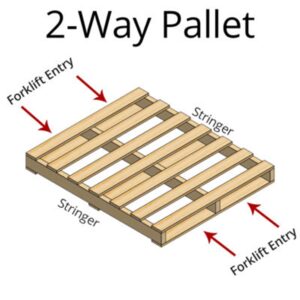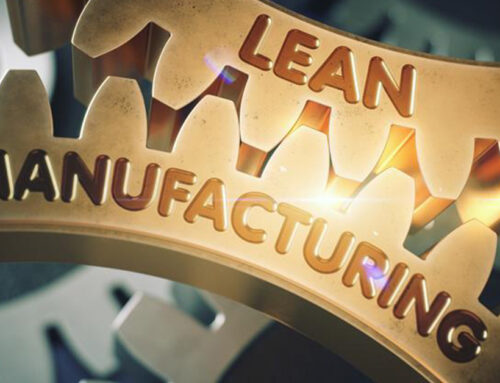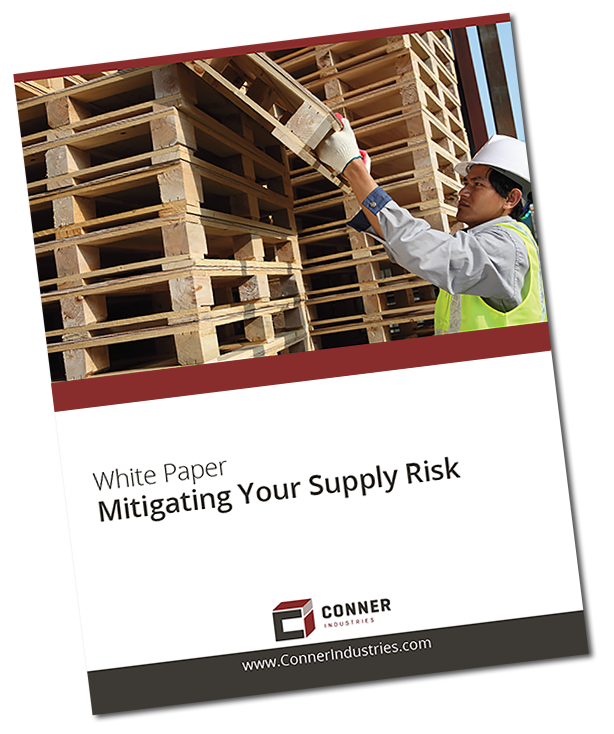
Why Should You Invest In a 4-way Pallet?
Our goal is to provide the best solution while being the most informative in doing so when it comes to the Frequently Asked Questions (FAQ). Reading this article will give insight on what a pallet is, the different variants, and how they rank against each other. We provide the pros and cons to show that a 4-way pallet is essentially better in the long run.
2-Way vs 4-Way Pallet: What’s the Difference?
Every wooden pallet is built in either 2-way or 4-way pallets. Let’s take a deeper dive into these two and see what these are, so that way we can check out the differences. A pallet is a storing device that allows you to transport goods.
The first option of a pallet is a 2-way pallet. A 2-way entry pallet are pallets that have an entrance from two sides. Meaning that it can only be picked up in two ways by a forklift through those entry point(s). An entry point is a space between the boards on a pallet deck where a forklift can lift the pallet and relocate it if needed. A 4-way entry pallet are the same concept of pallets but instead of 2 entries, there are now 4.
When looking at 4-way pallets, you will notice “stringers.” A stringer is a board on either side of the pallet and in the middle that runs from one end to the other and gives the pallet more support. These stringers will allow for more to be stacked on top of the pallets. Think about if you have a house, you need 4 walls to complete a house. The walls are essentially the “stringers” that make it complete. Without those 4 walls, you cannot complete the house and stack a roof on top.
Block pallets are a different type of pallet that incorporates blocks to support the deck, opposed to stringers. Block pallets are another type of 4-way pallet because the tines of a forklift or hand truck can enter the pallet on all four sides. Block pallets usually use about 4 to 12 blocks to help the top deck board into supporting it.
The difference between a stringer and block pallet is that stringers are connected throughout the whole pallet whereas the block is only connected in some parts to somewhat act as a “platform” for it.
What is the Difference Between 2-Way and 4-Way Pallets?
Both pallets are used in many commercial and industrial applications. There are different implications on why one certain type of pallet would be chosen over the other. Some of the reasons could be how that pallet will be handled, and what is best for the facility.
Specialization over a certain type of pallet is very common, and that specific facility will usually only work with those specific type of pallets. For example, if space is at premium then a 4-way pallet would make more sense because palletized products can be moved within a facility more easily with less space.
2-Way Pallet
Advantages:
- Cheaper To Manufacture: Since there are fewer entry points, these pallets make planning and building easier which leads to lower costs to manufacture.
Disadvantages:
- Higher utilization of space: Forklifts need more space to line up these pallets, since there are fewer entry points. The pallet can only be accessed from the front or the back.

*Also, these pallets must be placed in the truck a certain way of which can be reached by a forklift of pallet jet. This results in less cargo being able to be stored in one load. *
4-Way Pallet

Advantages:
- Easy Handling: 4-way pallets can be picked up from ANY side since there is an entry point on every side.
- Less utilization of Space: These pallets unlike the two-way can be placed closer on a rack which allows for more available room in total.
- Able to Load More: These pallets can be loaded from any side which allows trucks to load more.
Disadvantages:
- Higher Cost: More planning and effort into these pallets cause higher costs in the initial investment but can be worth it long term for certain needs.
- Able To Hold Less: Due to the stringers, these pallets are not able to hold as much weight as the other pallets.
Wrapping It Up
Essentially, these two types of pallets provide specific needs to the facility that stores them and comes down to how many sides a forklift or hand truck can enter the pallet. Through discussing the 2-way and 4-way pallet, we were able to check out the advantages and disadvantages of both to provide insight on what to purchase.
The answer is that while both types of pallets provide advantages, ultimately the 4-way pallet comes with more benefits that will not just help in the short run but the long run as well.
Choosing the right type of pallet will largely depend on the specific needs of your facility, how much space you have, and how the pallet will be used. Here at Conner Industries, we have 40+ years of experience and our design team can help you figure that part out when you are ready to move forward.

![[PRESS RELEASE] Conner Industries Expands Integrated Packaging Division with Acquisition of Kirkland Sales Inc.](https://connerpackaging.b-cdn.net/wp-content/uploads/2024/05/Foam-Page-Featured-500x383.jpg)









